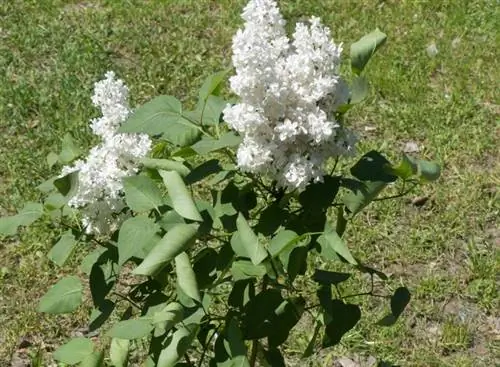- Author admin [email protected].
- Public 2023-12-16 16:46.
- Last modified 2025-01-23 11:21.
Planted in the right location, lilac is a very fast-growing shrub that grows between 30 and 50 centimeters in height and width per year. This growth is of course dependent on the variety, because dwarf lilacs, which only grow up to 150 centimeters high, are significantly slower at an average of five to 20 centimeters per year. However, if the lilac doesn't really want to grow, it can have various reasons.

Why isn't my lilac growing?
If a lilac bush does not grow, it may be due to incorrect location, unsuitable soil, nutrient deficiency or disease. This can be remedied by a sunnier spot, soil improvement, organic fertilizer or pruning in the event of an infestation.
Common causes of lack of growth
A lilac that doesn't want to grow often doesn't bloom or only blooms a little. Both behaviors are a clear indication that something is wrong with the undemanding shrub. In most cases, the problem is related to the location - it is too dark, the soil is too heavy, not permeable or contains too few nutrients. However, sometimes an infection with a pathogen can also be the cause. Lilacs are particularly susceptible to fungi.
Wrong location
Sun, sun and even more sun - Syringa, as the lilac is botanically called, needs a location in full sun where it is in direct light for at least four hours a day. If it is too dark for it (for example because a larger tree casts shadows at certain times of the day), it will not grow despite otherwise he althy appearance and will often stop blooming. The only thing that helps is moving to a sunnier place.
Unsuitable soil / waterlogging
The lilac also does not like heavy, clayey soil: here it cannot spread its roots, which run meters deep beneath the ground, unhindered, and these soils often lack nutrients. However, moisture builds up here, which in turn can result in waterlogging due to the location - with the result that the roots of the lilac rot. Here too, only moving to more suitable soil or thoroughly improving the soil will help.
Nutrient Deficiency
A nutrient deficiency often occurs in very sandy or heavy soils, which should therefore be improved at planting. As an acute help, you can provide the lilac with an organic fertilizer; compost is particularly suitable. If you mulch the root disc, there may also be a nitrogen deficiency.
Weakening by diseases
If the puny lilac has brown leaves or leaf spots, there is probably a disease caused by a bacterium or fungus. Pruning and strengthening the bush with field horsetail, which is applied as a decoction, helps here.
Tip
Sometimes the root pressure from neighboring plants or the lawn in which the lilac is standing also results in reduced growth. In this case, the lilac simply doesn't have enough space.






